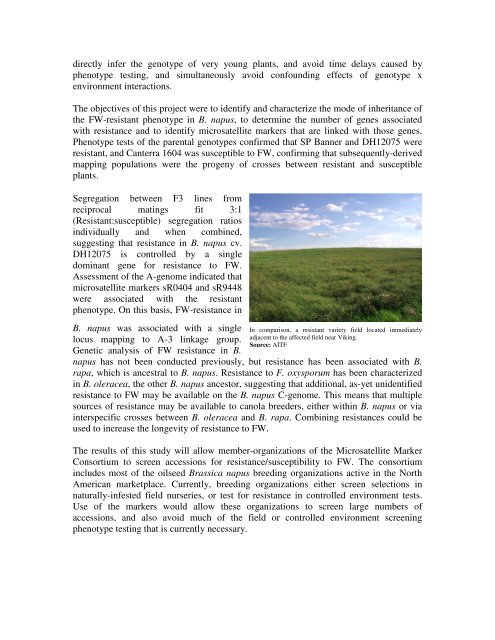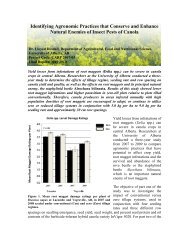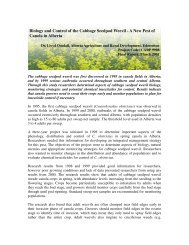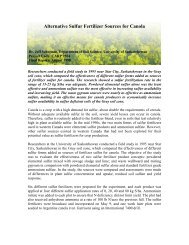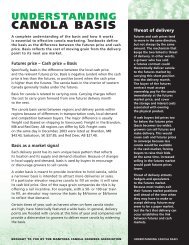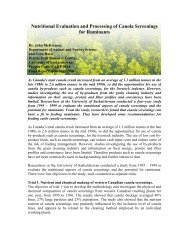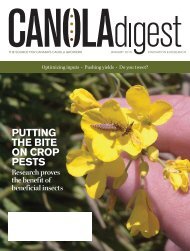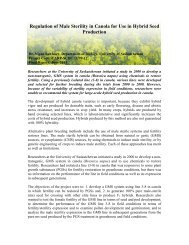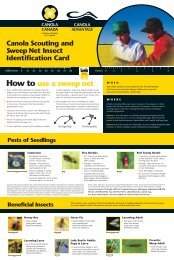Marker-Assisted Breeding for Fusarium Wilt ... - SaskCanola
Marker-Assisted Breeding for Fusarium Wilt ... - SaskCanola
Marker-Assisted Breeding for Fusarium Wilt ... - SaskCanola
You also want an ePaper? Increase the reach of your titles
YUMPU automatically turns print PDFs into web optimized ePapers that Google loves.
directly infer the genotype of very young plants, and avoid time delays caused by<br />
phenotype testing, and simultaneously avoid confounding effects of genotype x<br />
environment interactions.<br />
The objectives of this project were to identify and characterize the mode of inheritance of<br />
the FW-resistant phenotype in B. napus, to determine the number of genes associated<br />
with resistance and to identify microsatellite markers that are linked with those genes.<br />
Phenotype tests of the parental genotypes confirmed that SP Banner and DH12075 were<br />
resistant, and Canterra 1604 was susceptible to FW, confirming that subsequently-derived<br />
mapping populations were the progeny of crosses between resistant and susceptible<br />
plants.<br />
Segregation between F3 lines from<br />
reciprocal matings fit 3:1<br />
(Resistant:susceptible) segregation ratios<br />
individually and when combined,<br />
suggesting that resistance in B. napus cv.<br />
DH12075 is controlled by a single<br />
dominant gene <strong>for</strong> resistance to FW.<br />
Assessment of the A-genome indicated that<br />
microsatellite markers sR0404 and sR9448<br />
were associated with the resistant<br />
phenotype. On this basis, FW-resistance in<br />
B. napus was associated with a single<br />
locus mapping to A-3 linkage group.<br />
Genetic analysis of FW resistance in B.<br />
In comparison, a resistant variety field located immediately<br />
adjacent to the affected field near Viking.<br />
Source: AITF<br />
napus has not been conducted previously, but resistance has been associated with B.<br />
rapa, which is ancestral to B. napus. Resistance to F. oxysporum has been characterized<br />
in B. oleracea, the other B. napus ancestor, suggesting that additional, as-yet unidentified<br />
resistance to FW may be available on the B. napus C-genome. This means that multiple<br />
sources of resistance may be available to canola breeders, either within B. napus or via<br />
interspecific crosses between B. oleracea and B. rapa. Combining resistances could be<br />
used to increase the longevity of resistance to FW.<br />
The results of this study will allow member-organizations of the Microsatellite <strong>Marker</strong><br />
Consortium to screen accessions <strong>for</strong> resistance/susceptibility to FW. The consortium<br />
includes most of the oilseed Brassica napus breeding organizations active in the North<br />
American marketplace. Currently, breeding organizations either screen selections in<br />
naturally-infested field nurseries, or test <strong>for</strong> resistance in controlled environment tests.<br />
Use of the markers would allow these organizations to screen large numbers of<br />
accessions, and also avoid much of the field or controlled environment screening<br />
phenotype testing that is currently necessary.


